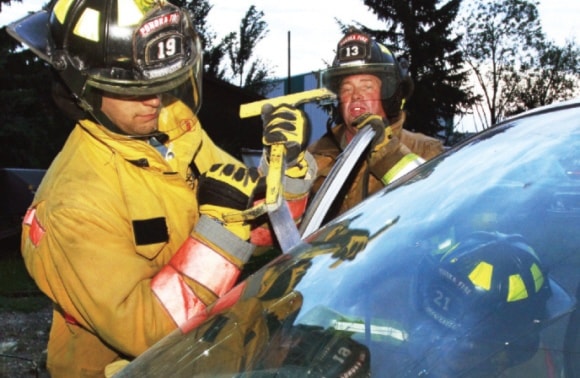The sound of screeching tires and metal crunching on metal is one of the first things a person hears in a car accident and one of the last sounds you want to hear.
What’s worse is being unable to get out.
It takes three minutes from when the first tone goes off that voluntary firefighters head out on some emergency, which could be anything. Whatever the situation — a home or grass fire, a pot burning on a stove, emergency assists and collisions, these guys rush to ensure lives can be saved.
As firefighters leave the fire hall in a blaze of lights and sirens, children watch from classroom windows or playgrounds. Children usually crowd school fences and wonder where these volunteer firefighters are heading next, their imaginations working overtime and thinking of doing the same thing when they get older.
Everything else becomes secondary as volunteer firefighters rush to a scene. Dealing specifically with collisions, Ponoka’s crew gets special training on life saving techniques.
If a victim is stuck in a car from a collision, the only way out is with the Jaws of Life and members of the Ponoka Fire Department have the experience and training to do it. The volunteer fire department has one goal: to get you out alive. Most people don’t realize this but firefighters not only train on how to safely extricate an individual, they are also concerned for a person’s mental state.
At a recent exercise, captains Bill Crawford and Kelly Moore walked everyone through important procedures during an actual extrication.
The seriousness of the situation means there is little time for pleasantries. If a fire officer has more experience with the equipment and tells his counterpart to move, they move, explained Crawford. “Somebody that’s there that does have a lot of experience can do a better job… Don’t take anything personal when we’re on the scene.”
“I suggest if someone does take a tool out of your hands, follow in behind them,” he added. “Watch what he does, give him any assistance he needs.”
A victim’s needs come before ego for the fire department.
Their job is to get quick, safe access to the passenger. This allows paramedics a chance to inspect a person and firefighters to extricate them.
The best way to prepare for extrication?
“You assume there’s one every time,” explained Moore.
The Ponoka Fire Department goes to every collision with the expectation they will have to use the Jaws of Life.
The equipment is a complicated array of hoses, an air compressor, generator, blocks of wood and the jaws themselves. Because of the force used to rip apart doors to gain access to the vehicle, wood wedges help keep it balanced. This ensures the passenger is not moved around too much, said Crawford. “After you stabilize the vehicle you start bringing the tools.”
Firefighters will also break glass to help them gain access. Victims are covered with a blanket to stop glass from causing cuts; at the same time firefighters speak in calm confident tones warning of the eminent breakage. The sound of a door being cut and pried back is unpleasant but there is some ease to the worry while crews constantly advise what to expect.
“Whenever you break glass, always announce, ‘breaking glass,’” stated Moore.
The first thing emergency crews tell you is, “We won’t let you get in harm’s way,” added Crawford.
A special tool is used to break the glass but the sound of windshield cracking and crunching is unnerving; it feels uncomfortable landing on your lap too but the blanket and reassuring words from firefighters helps. All the while someone is behind the passenger holding their neck to prevent injury and explaining everything that is happening.
While glass was being broken the firefighters have their chins down and helmets on. Their protective equipment helps prevent glass shards from finding a way into their suits and injuring them while on the job. Their goal is to get everyone out alive.
Things can go wrong extremely fast in a scene; fuel can leak and motorists who may not be watching the road are just some of what firefighters need to watch out for. “If any of you see a safety concern, (go) on the radio and say ‘Freeze!’” Crawford stated.
Everyone will stop at that point to correct any errors before proceeding.
“Everything’s supposed to stop,” added Moore.
Despite working with relatively light equipment, the jaws weigh 10 to 15 pounds so moving heavy gear and using the jaws over an extended period of time can be exhausting.
“They don’t seem that heavy but if you’re working with them it’s tough,” explained Moore.
All of this is done to ensure a patient gets out to see another day. Emergency calls do not have a schedule. Firefighters prepare themselves for 30 degrees C weather or minus 40 degrees C, most crews put a set of clothing on the side of their beds at night and many tell stories of having to throw away damaged pants. Those same firefighters can also tell you the last time they pulled someone out of a burning home or helped resuscitate someone back to life.
If you see a car speeding past with a flashing green light, pull over, your Ponoka firefighters are heading out to a scene.
